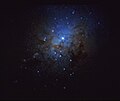Perseus heap
The Perseus Cluster ( Abell 426) is a galaxy cluster in the constellation Perseus . It's about 240 million light years away. Its mean radial speed is around 5400 kilometers per second. It is one of the nearest rich galaxy clusters and comprises around 500 to 1000 galaxies spread across the sky over an area with a diameter of around 15 °. It consists mainly of yellowish elliptical and lenticular galaxies and has an estimated total mass of 2 · 10 15 solar masses. According to the Rood and Sastry scheme ( RS scheme ), the heap is classified as type L due to its elongated shape.
The Perseus Cluster contains, among other things, the strong radio source Perseus A (3C 84), which is associated with the huge cD galaxy NGC 1275 in the center of the cluster. The plasma in the center of the cluster around NGC 1275 is so hot that the mean speeds of the ions are comparable to the speed of light; this is called a relativistic plasma. The intergalactic gas in the core of the Perseus Cluster is estimated at ten million Kelvin to 100 million Kelvin. It is also the source of strong X-rays that make the Perseus Cluster the brightest galaxy cluster in this spectral range.
In 2003, astronomers discovered in the center of the galaxy cluster the lowest measured acoustic tone in the universe at that time and caused a sensation. After 53 hours of observation through the Chandra space X-ray telescope , the researchers were able to make out sound waves within the relativistic gas that surrounds a huge black hole in the center of the cluster. The wavelength is close to the note B, 57 octaves below the dashed C.

A cold front is suspected in the X-ray data from the Chandra space telescope. Simulations have shown that this cold front could be a Kelvin-Helmholtz instability . It is believed that this instability stems from another galaxy cluster that passed the Perseus Cluster more than a billion years ago and triggered the instability. The size of this wave is about 200,000 light years.
gallery
The galaxy NGC 1275 in the center of the Perseus Cluster
Web links
- alpha-Centauri: How does Perseus sound? Bayerischer Rundfunk, first broadcast March 3, 2004, accessed on June 24, 2017.
- Statistics of galaxies of the Perseus Cluster
- Galaxies of the Perseus Cluster - Astronomy Picture of the Day of May 8, 2009.
- The Perseus Cluster of Galaxies - Astronomy Picture of the Day from October 25, 2004 (English).
- astronews.com: Unexpected finds in the Perseus Cluster. 23rd August 2017.
- scinexx .de: Cosmic cold front puzzles on April 5, 2018
Individual evidence
- ↑ Detailed information from NASA / IPAC EXTRAGALACTIC DATABASE on Perseushaufen.
- ↑ The silent intracluster medium at the core of the Perseus cluster. In: vsda.de. Retrieved on May 6, 2019 (German).
- ^ Robert Gendler: A Year in the Life of the Universe: A Seasonal Guide to Viewing the Cosmos . Voyageur Press, 2006, ISBN 978-0-7603-2642-8 , pp. 47 ( books.google.de ).
- ↑ AC Fabian et al. a .: A deep Chandra observation of the Perseus cluster: shocks and ripples. 2003, MNRAS , 344, L43, bibcode : 2003MNRAS.344L..43F .
- ↑ Dirk Eidemüller: A vortex for half eternity. A huge wave is rolling through the Perseus galaxy cluster. Astronomers have now found a possible explanation for this. June 18, 2018, accessed June 28, 2018 .
- ↑ SA Walker, J. Hlavacek-Larrondo, M. Gendron-Marsolais, AC Fabian, H. Intema, JS Sanders, JT Bamford, R. van Weeren: Is there a giant Kelvin-Helmholtz instability in the sloshing cold front of the Perseus cluster? In: Monthly Notices of the Royal Astronomical Society . tape 468 , no. 2 , June 21, 2017, p. 2506-2516 , doi : 10.1093 / mnras / stx640 .


